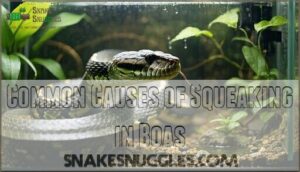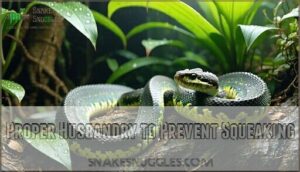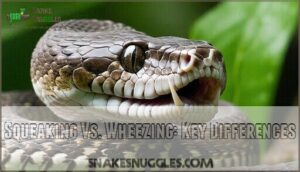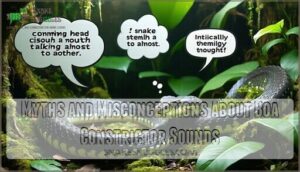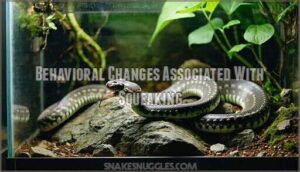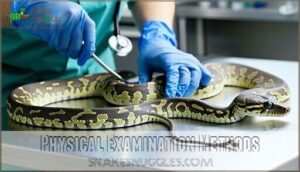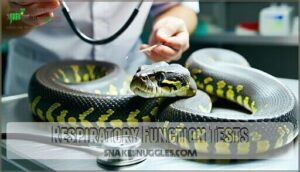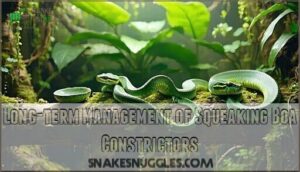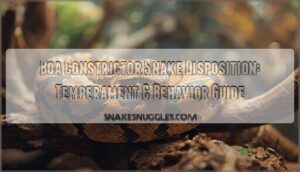This site is supported by our readers. We may earn a commission, at no cost to you, if you purchase through links.

Boa constrictor squeaking often stems from respiratory infections, stress, or improper humidity levels in their enclosure. Unlike their normal hissing, squeaking indicates something’s off with their breathing passages.
Think of it like your snake having a stuffy nose that won’t quit. Environmental factors like incorrect temperatures, poor ventilation, or excessive moisture create perfect conditions for these issues.
While occasional soft breathing sounds might be normal, persistent squeaking calls for immediate husbandry adjustments and possibly veterinary care to prevent serious complications.
Table Of Contents
- Key Takeaways
- Understanding Boa Constrictor Squeaking
- Common Causes of Squeaking in Boas
- Distinguishing Squeaking From Other Snake Sounds
- When to Seek Veterinary Care for Squeaking
- Proper Husbandry to Prevent Squeaking
- Squeaking Vs. Wheezing: Key Differences
- Myths and Misconceptions About Boa Constrictor Sounds
- Behavioral Changes Associated With Squeaking
- Diagnostic Techniques for Identifying Squeaking Causes
- Long-term Management of Squeaking Boa Constrictors
- Frequently Asked Questions (FAQs)
- Do boa constrictors make sounds?
- What snake makes a squeaking noise?
- Should I mist my boa constrictor?
- Do boa constrictors like to be held?
- Why does my snake keep squeaking?
- Why is my boa constrictor wheezing?
- Why can I hear my boa breathing?
- What is a boa constrictor choke hold?
- How much pressure does a boa constrictor squeeze?
- How do boa constrictors suffocate?
- Conclusion
Key Takeaways
- You’ll know your boa constrictor’s squeaking typically signals respiratory problems, stress, or improper humidity levels – not normal communication like hissing.
- You need to maintain 60-70% humidity and 75-85°F temperature gradients in your boa’s enclosure to prevent most squeaking issues from developing.
- You should seek immediate veterinary care if squeaking persists beyond shedding cycles, especially when paired with lethargy, open-mouth breathing, or stringy saliva.
- You can distinguish squeaking from wheezing by recognizing that squeaking sounds sharp and high-pitched during inhalation, while wheezing creates continuous musical hissing during exhalation.
Understanding Boa Constrictor Squeaking
You’re not losing your mind – your boa constrictor squeaking is actually trying to tell you something important.
Your squeaking snake isn’t broken – it’s communicating something crucial about its health and wellbeing.
These mysterious sounds aren’t random noise but serve as your snake’s way of communicating discomfort or health concerns. Unlike birds or mammals, snake vocalization doesn’t include mating calls or social chatter, making each sound particularly significant.
Boa communication through squeaking often indicates underlying issues requiring your attention. The sound amplification effect of terrarium walls can make these noises seem more pronounced than they actually are, which might initially startle new owners.
Understanding squeak identification becomes essential since these high-pitched sounds differ from normal hissing or breathing patterns.
Various squeaking triggers exist, from environmental stress to potential respiratory infection. While snake sounds can seem alarming, recognizing normal versus concerning boa constrictor sound patterns helps you respond appropriately.
Effective squeaking prevention starts with understanding what your snake is trying to communicate through these vocalizations.
Common Causes of Squeaking in Boas
You’ll encounter squeaking in your boa constrictor for several distinct reasons, ranging from minor shedding issues to serious respiratory infections that require immediate veterinary attention.
The most common culprits include blocked nostrils from retained shed skin, environmental stress from improper humidity or temperature levels, early-stage respiratory infections, and normal digestive processes that occasionally produce unusual sounds.
Respiratory Infections
Respiratory infections are your boa’s biggest squeaking culprit. Bacterial infections and pneumonia create telltale wheezing sounds alongside that concerning squeak.
When your boa squeaks, it’s speaking a language of discomfort that demands your immediate attention.
Infection symptoms include stringy saliva, lethargy, and respiratory distress. Contagion risk means isolating your snake immediately.
Veterinary diagnosis determines appropriate treatment options, typically antibiotics. One common cause is incorrect environmental humidity.
Preventative measures include proper humidity and temperature control to avoid respiratory issues.
Stress and Environmental Factors
Environmental upheaval triggers your boa’s stress response, often manifesting as squeaking sounds.
Temperature fluctuations above 82°F and humidity impact below 90% create respiratory distress. Shedding stress compounds these issues during vulnerable periods.
These squeaks could be an early sign of pneumonia.
Key stress indicators include:
- Abrupt changes in climate or handling stress
- Poor enclosure enrichment lacking hiding spots
- Inadequate thermal gradients preventing proper thermoregulation
- Dusty substrates causing respiratory irritation
Digestive Issues
Your boa’s digestive system can trigger boa constrictor squeaking when things go sideways.
Constipation causes discomfort that manifests as unusual sounds, while diarrhea creates similar stress responses.
Diet changes shock their system, and impaction risks from improper prey size compound problems.
Parasite squeaking occurs when internal worms irritate their gut, creating digestive problems that affect breathing patterns.
Normal Breathing Variations
Just like people breathe differently during various activities, your boa constrictor may produce occasional squeaking sounds during normal breathing patterns.
Resting respiration typically stays quiet, but postural breathing changes when your snake shifts position.
Exertion sounds emerge during movement, while shedding noises occur naturally during skin cycles.
Proper hydration effects can minimize these normal variations in snake sounds.
Distinguishing Squeaking From Other Snake Sounds
Sound identification becomes your detective work when distinguishing boa constrictor squeaking from other snake sounds. Each noise carries specific meaning, and context matters when interpreting what your snake communicates. Acoustic differences help you decode whether that sound signals trouble or normal behavior.
Snake sounds interpretation requires careful observation of accompanying behaviors. Here’s what different sounds typically indicate:
- Hissing: Defensive warning with flattened body posture and open mouth
- Wheezing: Potentially serious respiratory infection requiring immediate attention
- Clicking: Often jaw-related issues or normal hunting preparations
- Rasping: Usually stress-related or early respiratory concerns
- Popping: Common during feeding time or active shedding periods
Squeaking vs wheezing presents the trickiest distinction. Squeaking tends to be higher-pitched and intermittent, while wheezing sounds deeper and more continuous. Vocalization purpose varies dramatically—squeaking might indicate minor nostril blockages, but wheezing suggests serious respiratory distress. Hissing indicates warning and is a common defensive mechanism across snake species. Sound interpretation improves with experience, so document patterns you notice in your boa’s vocalizations.
When to Seek Veterinary Care for Squeaking
Recognizing when your boa’s squeaking crosses from quirky to concerning can save their life.
Boa constrictor squeaking paired with lethargy signs demands immediate veterinary care.
Open-mouth breathing represents a respiratory emergency requiring urgent attention.
Watch for infection symptoms like stringy saliva, mucus bubbles, or appetite loss – these red flags signal serious snake health issues.
Don’t wait if squeaking persists beyond shedding cycles.
A respiratory infection won’t resolve alone, and early veterinary care prevents complications.
Your reptile vet can diagnose underlying causes and prescribe appropriate treatment before minor issues become major problems.
Proper Husbandry to Prevent Squeaking
You can prevent most squeaking issues in your boa constrictor by maintaining proper temperature gradients of 75-85°F, humidity levels between 60-70%, and providing a clean enclosure with appropriate substrate.
Consistent environmental conditions, combined with regular feeding schedules and stress-free handling practices, will keep your snake’s respiratory system healthy and reduce the likelihood of squeaking sounds.
Temperature and Humidity Control
Getting your boa’s environment just right isn’t rocket science, but it requires attention to detail.
Temperature and humidity control work hand-in-hand to prevent respiratory squeaking.
Here’s your environmental checklist:
- Heating gradients: Maintain 82-85°F warm side, 75-80°F cool side
- Humidity monitoring: Keep levels between 60-80% using reliable hygrometers
- Water sources: Provide dual bowls, one over heat for moisture
Appropriate heating may require a specialized enclosure heater.
Enclosure Setup
Three key elements make your enclosure setup work like a well-oiled machine.
Environmental conditions directly impact your boa’s respiratory health, so getting tank conditions right prevents squeaking episodes. You can maintain proper humidity with suitable substrate options.
| Setup Element | Best Choice |
|---|---|
| Substrate Choices | Cypress mulch or orchid bark |
| Hiding Spots | Two secure caves (warm/cool sides) |
| Water Dishes | Large bowl on warm side |
| Enclosure Size | 6x4x4 feet minimum for adults |
| Lighting Needs | UVB bulb plus ceramic heater |
Diet and Nutrition
A nutritious diet forms the foundation of your boa’s respiratory health, directly impacting squeaking episodes. Prey size should match your snake’s mid-body width, while feeding frequency depends on age—juveniles weekly, adults bi-weekly.
Proper supplementation with calcium prevents deficiencies that stress the system. Boa constrictors require appropriately sized meals; consider boa’s ideal prey to promote healthy well-being.
- Monitor hydration levels through skin elasticity tests
- Adjust feeding schedule based on seasonal activity patterns
- Prevent obesity by maintaining appropriate meal sizes
- Watch for food allergies causing digestive stress
Squeaking Vs. Wheezing: Key Differences
You’ve mastered proper husbandry, but now you need to distinguish between squeaking sounds and wheezing in your boa.
These snake respiratory problems have different underlying causes and require distinct diagnostic methods.
| Aspect | Squeaking | Wheezing |
|---|---|---|
| Sound Characteristics | Sharp, high-pitched whistle during inhalation | Musical, continuous hissing during exhalation |
| Primary Cause | Upper airway obstruction or throat inflammation | Narrowed lung airways from respiratory infection |
| Treatment Approach | Address blockages, humidity adjustments | Antibiotics, nebulization therapy |
Squeaking indicates upper respiratory issues, while wheezing signals deeper lung problems.
A common cause is respiratory bacterial infections that can affect snakes.
Understanding these differences helps you choose appropriate treatment options and preventative measures for your snake’s health.
Myths and Misconceptions About Boa Constrictor Sounds
Now that you understand the difference between squeaking and wheezing, let’s bust some widespread myths about boa constrictor sounds.
Many people believe boas are completely silent creatures, but that’s simply not true.
Your snake isn’t mute – it’s just speaking a different language.
Here are the most common misconceptions about boa constrictor sound:
- Vocal Mimicry doesn’t exist in boas – they can’t copy human voices or other animal sounds
- Squeaking Communication isn’t a mating call or social signal between snakes
- Sound Amplification from terrarium walls often makes normal breathing seem louder than it actually is
Hissing Intent serves as a warning, not conversation.
Shedding Noises like squeaking happen due to physical changes, not emotional states.
Understanding snake communication means recognizing that boa constrictor squeaking typically indicates health or environmental issues rather than attempts at chatting with you.
Behavioral Changes Associated With Squeaking
Beyond the myths surrounding snake sounds, behavioral changes often accompany boa constrictor squeaking and reveal what’s really happening with your pet.
You’ll notice handling sensitivity increases when your boa starts making squeaking sounds – they might tense up or become more defensive during routine interactions. Shedding behavior changes dramatically, with boas becoming restless and seeking rough surfaces for surface contact to help remove old skin.
Amplified sounds from terrarium walls make squeaking more noticeable, especially when your snake moves against enclosure surfaces.
Watch for insecurity signs like excessive hiding, refusing food, or positioning themselves in corners. These communication attempts through snake behavior signal discomfort or stress.
Recognizing these changes can be vital, as increased tongue flicking might indicate hunger. Boa constrictor squeaking paired with lethargy or open-mouth breathing demands immediate attention, as these combinations indicate serious health concerns requiring veterinary care.
Diagnostic Techniques for Identifying Squeaking Causes
You’ll need systematic diagnostic methods to pinpoint the exact cause of your boa’s squeaking, since multiple factors can produce similar sounds.
Professional veterinarians use physical examinations, respiratory function assessments, and imaging techniques to distinguish between stress-related squeaking, respiratory infections, and environmental issues.
Physical Examination Methods
Your vet’s physical examination methods start with hands-on detective work.
They’ll use palpation techniques to feel for abnormal lumps, perform visual inspection of nostrils and mouth, and conduct auscultation findings by listening to breathing patterns. Hydration assessment and weight monitoring complete the picture.
Key examination steps include:
- Checking nasal passages for blockages or discharge
- Palpating the throat and neck for swelling
- Observing breathing rhythm and effort
- Evaluating skin elasticity and color
- Documenting behavioral responses during handling
Respiratory Function Tests
Respiratory function tests help your vet measure lung capacity and detect airflow obstruction in your squeaking boa.
These tests assess gas exchange efficiency and blood oxygenation levels, pinpointing respiratory issues that cause squeaking.
Mucus analysis during testing reveals respiratory infection markers.
While specialized equipment isn’t always available, these veterinary diagnosis tools provide essential insights into your snake’s respiratory system health.
Imaging Techniques
When squeaking sounds puzzle you, advanced imaging techniques become your detective tools.
X-ray imaging reveals pneumonia patterns, while ultrasound uses help examine heart function. CT scans provide detailed lung views, and MRI benefits include soft tissue clarity.
Thermography applications detect inflammation hotspots. These diagnostic techniques help veterinarians pinpoint respiratory infection causes in your boa constrictor, ensuring targeted treatment plans.
Veterinarians might utilize specialized X-ray equipment for detailed imaging.
Long-term Management of Squeaking Boa Constrictors
Once you’ve pinpointed why your boa constrictor is making those squeaking sounds, creating a solid long-term management plan becomes your next priority.
Think of it as building a fortress against future respiratory infections and stress-related issues.
Here’s your roadmap for successful long-term management:
- Humidity maintenance – Keep levels between 60-70% consistently to prevent respiratory problems
- Preventative care – Schedule regular vet visits every 6-12 months for early detection
- Enclosure enrichment – Add hiding spots and climbing branches for stress reduction
- Diet optimization – Maintain proper feeding schedules and monitor antibiotic therapy effectiveness
Frequently Asked Questions (FAQs)
Do boa constrictors make sounds?
Yes, your boa constrictor can make various sounds including hissing, squeaking, clicking, popping, and wheezing.
These sounds serve different purposes, from defense mechanisms to potential health indicators you’ll want to monitor.
What snake makes a squeaking noise?
Several snake species make squeaking noises, including boa constrictors, ball pythons, and corn snakes.
You’ll typically hear these sounds when they’re stressed, shedding, have respiratory issues, or something’s blocking their nostrils.
Should I mist my boa constrictor?
Picture droplets dancing through humid air like morning dew.
You shouldn’t directly mist your boa constrictor, as water droplets can cause respiratory issues.
Instead, maintain 60-70% humidity using water bowls and proper substrate to ensure a healthy environment for your boa constrictor, and remember to handle them with care.
Do boa constrictors like to be held?
Most boas tolerate handling well once they’re comfortable with you, but they don’t seek affection like mammals do.
They’ll remain calm during brief sessions, though some may show stress through body language or occasional squeaking sounds, and this can be an important indicator of their comfort level.
Why does my snake keep squeaking?
Snake squeaking usually signals respiratory issues, stuck shed skin, or stress from improper humidity levels. Check your enclosure’s temperature and humidity immediately, then consult a reptile veterinarian if squeaking persists.
Why is my boa constrictor wheezing?
Your boa’s wheezing typically signals a respiratory infection, which needs immediate veterinary attention. Poor humidity, incorrect temperatures, or stress can trigger these infections. Don’t wait—see a reptile vet quickly.
Why can I hear my boa breathing?
While silence typically signals a healthy snake, audible breathing often indicates trouble brewing.
You’re hearing respiratory sounds because your boa might’ve an infection, blocked nostrils, or inadequate humidity levels requiring immediate attention.
What is a boa constrictor choke hold?
You’ve probably heard this term describing how constrictors kill prey.
It’s actually constriction – your boa wraps around prey and tightens with each exhale, cutting off blood flow until circulation stops.
How much pressure does a boa constrictor squeeze?
Like a medieval knight’s armor crushing down, you’ll feel incredible force when a boa constrictor squeezes.
These powerful serpents apply 6-10 pounds per square inch of pressure, enough to stop your circulation and breathing within minutes.
How do boa constrictors suffocate?
Contrary to popular belief, you’ll find that boa constrictors don’t actually suffocate their prey. Instead, they squeeze tightly around the chest, stopping blood circulation and causing cardiac arrest within minutes.
Conclusion
Like a ship’s captain traversing troubled waters, you’ll need steady hands and sharp attention when addressing boa constrictor squeaking.
Remember that persistent squeaking isn’t just background noise—it’s your snake’s distress signal demanding immediate action.
By maintaining proper humidity levels, monitoring temperatures closely, and recognizing warning signs early, you’re equipped to prevent most respiratory issues.
Don’t hesitate to consult an exotic veterinarian when squeaking persists, because your boa’s health depends on swift, informed decisions.
- https://www.pinterest.com/pin/boa-constrictor-making-squeaking-sound--720787115355982839/
- http://www.therainbowboa.co.uk/forum/topic.asp?TOPIC_ID=1789
- https://community.morphmarket.com/t/boa-cinstrictor-vissle-sound/49045
- https://www.justanswer.com/veterinary/hty8n-pet-boa-constrictor-making-squeaky-noises.html
- https://www.tiktok.com/@blueridgegeckos/video/7182973023065034030?lang=en

